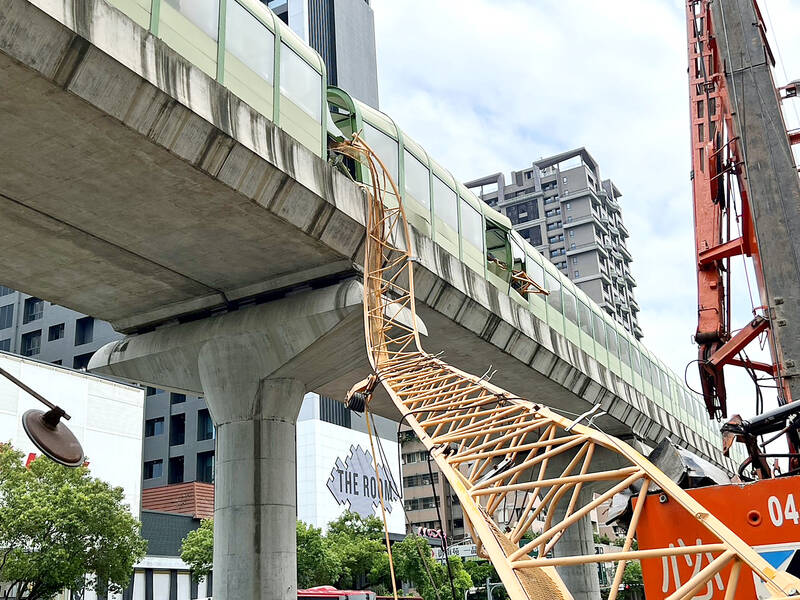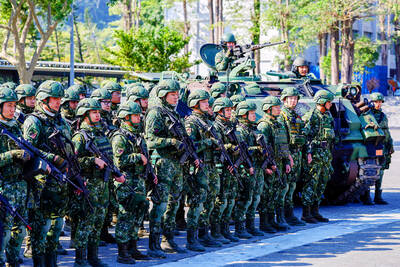Failure to properly operate a tower crane and a lack of clear measures for restricting or prohibiting construction on both sides of the Taichung mass rapid transit (MRT) system were the main reasons leading to a deadly crane collapse in May last year, an investigation conducted by the Taiwan Transportation Safety Board said yesterday.
On May 10 last year, an MRT train bound for the Taichung High Speed Rail Station crashed into a truss that fell onto the tracks between Feng-le Park Station and Daqing Station, killing one person and injuring 15.
The truss was later found to be from a construction site operated by Highwater Construction Co near the MRT route.

Photo courtesy of a reader via CNA
Contractors recruited by Highwater were using a tower crane to dismantle another tower crane that was used in construction, the board said.
“The crane operator might have tried to pull up a large truss diagonally, but the angle at which the operator made such a maneuver exceeded the limits of hoisting wires and truss lifting points, consequently twisting and breaking the truss,” the board said. “The truss eventually lost the support from the crane and fell to a road under the tracks, with part of it falling on the MRT line.”
The truss fell on the tracks at 12:27:03pm and the train departed from Feng-le Park Station at 12:27:29pm. At 12:27:31pm a security guard saw the truss on the tracks and waved his arms in a failed attempt to catch the attention of a staff member on board the train. The train hit the truss at 12:27:46pm, the board said.
Although a security guard saw the foreign object on the tracks, the guard failed to stop the train from leaving the station because there was no system on the platform for the station crew to halt the train in an emergency, the board said.
A staff member on board the train eventually detected the presence of a foreign object on the tracks and immediately asked the operations control center to stop the train, the board said.
The staff member also tried to use a key to open a board covering the train’s manual operating system to press the emergency brake button, but failed to unlock it in time, it said.
Investigators said that it would need about 15 to 16 seconds to unlock the board cover, but the staff member only had 12 seconds to do so after seeing a foreign object on the tracks.
The Measures for Prohibiting and Restricting Construction on Both Sides of the Mass Rapid Transit System (大眾捷運系統兩側禁建限建辦法) do not require contractors to conduct risk assessments and stipulate precautionary measures before they conduct high-altitude hanging operations in buildings, the board said.
Meanwhile, construction plans submitted by contractors working on-site in the proximity of important transportation hubs are only reviewed by agencies in charge of the projects, the board said, adding that there is no joint review mechanism between central and local government officials.
In Taiwan, contractors have no detailed procedures to abide by when they dismantle a tower crane, the board found.
Meanwhile, Taichung MRT Corp failed to set clear procedures to authorize its staff to halt trains in emergency situations, the board said.
It has neither standardized ways to communicate the need for trains to make a quick stop, nor track inspection procedures after incidents, it said.

UNILATERAL MOVES: Officials have raised concerns that Beijing could try to exert economic control over Kinmen in a key development plan next year The Civil Aviation Administration (CAA) yesterday said that China has so far failed to provide any information about a new airport expected to open next year that is less than 10km from a Taiwanese airport, raising flight safety concerns. Xiamen Xiangan International Airport is only about 3km at its closest point from the islands in Kinmen County — the scene of on-off fighting during the Cold War — and construction work can be seen and heard clearly from the Taiwan side. In a written statement sent to Reuters, the CAA said that airports close to each other need detailed advanced

Tropical Storm Fung-Wong would likely strengthen into a typhoon later today as it continues moving westward across the Pacific before heading in Taiwan’s direction next week, the Central Weather Administration (CWA) said. As of 8am, Fung-Wong was about 2,190km east-southeast of Cape Oluanpi (鵝鑾鼻), Taiwan’s southernmost point, moving westward at 25kph and possibly accelerating to 31kph, CWA data showed. The tropical storm is currently over waters east of the Philippines and still far from Taiwan, CWA forecaster Tseng Chao-cheng (曾昭誠) said, adding that it could likely strengthen into a typhoon later in the day. It is forecast to reach the South China Sea

WEATHER Typhoon forming: CWA A tropical depression is expected to form into a typhoon as early as today, the Central Weather Administration (CWA) said yesterday, adding that the storm’s path remains uncertain. Before the weekend, it would move toward the Philippines, the agency said. Some time around Monday next week, it might reach a turning point, either veering north toward waters east of Taiwan or continuing westward across the Philippines, the CWA said. Meanwhile, the eye of Typhoon Kalmaegi was 1,310km south-southeast of Oluanpi (鵝鑾鼻), Taiwan’s southernmost point, as of 2am yesterday, it said. The storm is forecast to move through central

Almost a quarter of volunteer soldiers who signed up from 2021 to last year have sought early discharge, the Legislative Yuan’s Budget Center said in a report. The report said that 12,884 of 52,674 people who volunteered in the period had sought an early exit from the military, returning NT$895.96 million (US$28.86 million) to the government. In 2021, there was a 105.34 percent rise in the volunteer recruitment rate, but the number has steadily declined since then, missing recruitment targets, the Chinese-language United Daily News said, citing the report. In 2021, only 521 volunteers dropped out of the military, the report said, citing